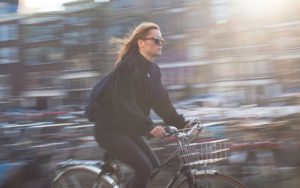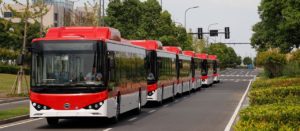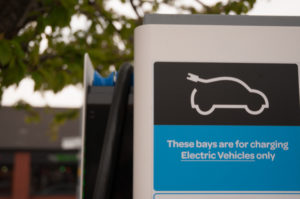Cars, trucks, and buses play a major role in our lives. They haul goods from manufacturers to stores, pick up our trash, deliver packages, and transport people around cities every day. However, urban transport emissions also greatly affect public health and climate change. Transport systems can benefit our health by giving opportunities for physical activity. It allows us access to employment, education, health services, food choices and social activities. These systems can also increase our health risks through exposure to air pollutants, noise emissions, and road traffic injuries.
The transport sector accounts for almost one-quarter of all global greenhouse gas (GHG) emissions and is one of the main contributors to air pollution in urban areas. Transport’s contribution to climate change includes long-lived carbon dioxide (CO2) and short-lived black carbon generated primarily by diesel vehicles. Studies have linked pollutants from fuel-powered vehicles to all types of adverse effects on organs in the human body.
Addressing vehicle pollution is critical for improving air quality and reducing global warming emissions worldwide. Sustainable transport strategies to reduce climate change also have large and immediate health benefits for the world’s population. This is especially true among vulnerable groups, such as the poor, older persons, children and adolescents, migrants, and refugees.
Looking at transport solutions through a health lens can help shape policies that go beyond access and speed. Transport policies can also benefit health, economic development, and climate-resilient cities. A number of tools exist to assess, plan, and finance healthy and climate-friendly transport.
An important framework for health-promoting transport solutions and reducing urban transport emissions is “avoid-shift-improve.” Avoid health harming and polluting transport and development policies; shift to healthy, environmentally friendly and active modes of transport; and improve fuel and vehicle technologies.
Here are the top five solutions to address transport emissions:
Solution 1- Encouraging active mobility (shift)

Walking and cycling can greatly improve urban air quality and human health. Data from the World Health Organization shows that 9 out of 10 people breathe polluted air that exceeds WHO guidelines. This leads to 4.2 million premature deaths every year. Additionally, two million people die annually from physical inactivity.
However, policies and infrastructure that improve access for one type of travel, like highways, may create barriers to pedestrians who would not be able to walk without a bridge. Poorly planned urban transport infrastructure also limits access to parts of the community by displacing residents or consuming public or green spaces.
Some of the attributes of a walkable city include transport decisions that prioritize pedestrians. People-centred town planning, housing connected to public transport, and regulations and infrastructure can minimise risks to pedestrians and cyclists.
Marginalised groups have less access to private or public transit and are more exposed to transport-related health risks. These same groups benefit most from improved public and non-motorized transport, which bolsters independent mobility.
Sustainable transport systems and compact, connected cities, featuring “15-minute self-sufficient neighbourhoods” can promote walking and cycling. Barcelona’s car-free “superblocks” have created safe pedestrian spaces. Several cities, including Dublin, London, Addis Ababa and Kigali, have made car-free days a regular event on their calendars. This encourages residents to run, walk, cycle and even play sports on the streets, all while reducing urban transport emissions. The “walking school bus,” popularized in Japan, has spread to several cities to encourage independent mobility with safe routes and designated stops for children to walk to and from school.
Solution 2 – Efficient mass transit (shift & improve)

Urban mobility is rapidly becoming one of the greatest challenges facing developed and developing countries. According to the WHO, 99% of the world’s population breathes air that does not meet WHO air quality guidelines for health. Transport is responsible for nearly a quarter of global energy-related CO2. Urban transport emissions are closely linked to respiratory diseases like asthma.
Aside from investing in walking and cycling infrastructure, the next best thing city governments can do is invest in clean, energy efficient and sustainable public transportation. Compared to single-occupancy vehicles, public transportation produces 95 per cent less CO2, 92 per cent fewer volatile organic compounds, 45 per cent less carbon monoxide, and 48 per cent less nitrogen oxide.
Shifting from private motorized transport to public transport, such as rail, metro and bus, is also associated with lower rates of traffic injury risk, reduced traffic congestion, less noise stress and improved equity of access for people without private vehicles.
Aside from reducing the number of private vehicles on the road, mayors in around 100 cities have said that investing in public transport, particularly in electric form, could create 4.6 million jobs by 2030.
Shenzhen, China, is the world’s first city to fully electrify its bus fleet. Apart from the noticeable noise reduction, the city’s 16,000 electric buses emit nearly 50 per cent less C02 and much fewer pollutants. Shenzhen Bus Group, the largest of the three bus companies in the city, estimates that an electric bus costs approximately $98,000 annually, compared to $112,000 for a diesel bus.
Solution 3 – Raising emission standards (improve)

Emission standards are legally enforceable regulations that stipulate the allowed rate of emissions into the atmosphere. Raising emissions standards for all vehicles takes heavy polluters off the road and drives market demand for cleaner vehicles — further reducing urban transport emissions.
Cities like London and Oxford have created Low-Emission Zones (LEZs), where the most polluting vehicles are prohibited. In some LEZs, the most polluting vehicles must pay more to enter the area. Studies conducted in Germany found that hospitals in LEZs diagnosed significantly fewer air pollution-related diseases than those outside of them, making LEZs an effective policy to reduce levels of air pollution in targeted areas.
In Europe, soot-free vehicles are typically certified to Euro 6. Euro 7, the final standard, will come into force in 2025 before the complete adoption of electric vehicles to limit climate change and air pollution further.
The Climate and Clean Air Coalition (CCAC), Heavy Duty Diesel Vehicles and Engines Initiative pushes for major reductions in black carbon emissions through adopting cleaner fuels and stricter vehicle regulations, particularly in emerging economies where diesel fuel is often of lower quality. The coalition has worked in Latin America and Asia to produce black carbon inventories, form national task forces, and set target dates for improved national fuel standards.
Solution 3 – Smart land-use policies (avoid)

Integrating transport and land-use policies is another way to reduce urban transport emissions by lessening the need for motorised trips. During the COVID-19 lockdowns, several cities enacted policies to allow for “tactical urbanism.” Oakland, California’s Slow Streets, Nairobi’s Placemaking Week and Mexico City’s #CAMINA had residents working together with authorities to improve access to public spaces and pedestrian safety through signage, reduced road speeds and closed streets to through-traffic.
Also, travel management strategies can reduce overall vehicle use, traffic congestion, road accidents, and emissions by mixing mobility choices and land-use policies. These strategies are often implemented by incentivizing alternatives. Carpool lanes, park-and-ride stations, or subsidized public transport for students discourage personal vehicle use, while implementing fuel taxes, parking fees, or traffic calming devices can also reduce emissions and road traffic accidents.
By considering transport and health linkages in urban spatial planning, policymakers can ensure that residential, business and social activities are located close to mass transit, further decreasing reliance on cars. Innovative examples include Atlanta’s transit-oriented soccer league, with a network of fields linked to mass transit stations, and Curitiba’s (Brazil) Bus Rapid Transit (BRT) system, where mass transit options are located in dense residential areas.
Solution 5 – Electric vehicles (improve)
In addition to emitting no harmful air pollution, electric vehicles have significantly lower climate change emissions than conventional cars. They produce no direct emissions through the tailpipe and fuelling process. Direct emissions are smog-forming pollutants, such as nitrogen oxides, and GHGs, like carbon dioxide.
Electric vehicles also typically produce fewer life-cycle emissions than conventional vehicles. This is because emissions from electricity generation are lower than those from burning gasoline or diesel.
The right policies and investments from city and national governments will accelerate the transition to a zero-emissions transportation system. In Norway, as many as 60 per cent of the cars sold in the country in 2020 were electric. In Kenya, the United Nations Environment Programme (UNEP) has partnered with the Shenzhen Shenling Car Company, rangers are piloting e-motorcycles to move around Nairobi’s 1000-hectare Karura Forest.
Cleaner vehicle technologies are an important element for reducing urban transport emissions and climate mitigation. However, reducing reliance on private vehicles and motorized transport is as important and can yield additional health benefits. Transit-oriented planning, which increases safe walking and cycling and the use of public transport, has direct benefits for health. Bus fleet improvements, policies mandating the inclusion of particle filters, low-sulphur diesel and the transition from diesel vehicles to compressed natural gas (CNG), electricity, or other alternative fuels decrease harmful emissions.
Additional resources:
HEAT tool for walking and cycling
WHO Strategies for healthy and sustainable transport
SLOCAT Transport and Climate Change Global Status Report (see: Focus Feature 5: Health Impacts of Transport)
